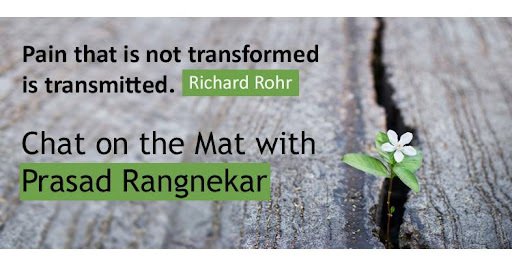The definition of pain is unique for everyone in every generation. We all have our own set of struggles and intense experiences. Have you wondered why some people stand strong in the face of difficulty as it comes while it leaves many, shattered, somewhat changing our identity completely that manifests in the form of fear, anxiety, unfeeling, detached, and reserved? While dealing with the complexities of life-taking fight or flight mode, we tend to develop a very stringent mindset towards people’s situations and our own life. Do you know that it’s our subdued pain and that it’s transmitted as a legacy to future generations and people around us?
Let’s understand this mystery of pain transformation from Prasad Rangnekar, Founder of Yogaprasad Institute Mumbai, an adept yoga mentor who has been to places in his spiritual quest with a profound understanding of various yogic dimensions especially meditation and philosophy. Prasad continues to unearth the mysteries of life and imparts the wisdom of yoga to the world.
Understanding Transformation of Pain by Prasad Rangnekar
hmy: How do you comprehend pain and suffering?
Prasad: The medico-neurological understanding of pain and suffering is complex but I see it in a simplistic way.
For me, pain is a feeling of discomfort that is mainly rooted in physical injury. On the other hand, suffering is a disagreeable state of mind which, may or may not, emerge from pain. There could be pain without suffering and vice versa.
hmy: Acknowledging and sharing our pain makes us weak or strong?
Prasad: There can be no conscious transformation in denial.
Recognizing where we are in our state of pain and acknowledging the need for an intervention is for me a mark of courage and honesty.
hmy: How can one transform from extreme conditions that are traumatic and intimidating?
Prasad: First and foremost, we all need to recognize that transformation of the extreme condition needs to be handled by professionals that are trained and equipped.
Many times physical pain goes away, but the mental trauma caused by that pain stays etched deep in the psyche. We need to recognize that the more severe the trauma, the more patience is needed for its transformation. In this sense, one needs to be ready to go through the gradual process of transformation patently. In my experience patience is strengthened by faith, faith in something more powerful than the fear itself.
These two, patience and faith, are the fundamental grounds on which the entire scope of transformation depends.
hmy: In what format does pain gets transmitted to people and generations?
Prasad: There are more and more studies pointing towards the idea that trauma and its effects can echo through the generations. Life events changing the expression of our DNA and this expression transferring to the next generation is known as a transgenerational epigenetic inheritance in modern science. We are still trying to understand how this inheritance takes place in a causal way.
There are a few theories about it, one theory states that the transfer takes place through RNA that is passed down from parents to children. The children of parents who have had experienced trauma show typical altered behavioral patterns like excess eating and a challenged ability to manage stress. Our genetic expression through our body-mind complex is not only due to information coded in the genes but also via the environment that has nurtured those genes.
Nature and Nurture, both contribute in a big way to what we are and what we become as a person. A parent’s trauma-altered behavior becomes the child’s growth ecosystem.
Growing up in a challenged ecosystem can make the child-sensitive and reactive to the everyday challenges of life. The sensitivity and reactiveness magnify as the child matures. When this child becomes a parent, she/he creates a hyper-sensitive and hyper-reactive environment for their children. And, this is how the growth environment has a big impact on the traits that we develop.
hmy: How can we identify and change our perspective towards life?
Prasad: We all live our life based on our vision (world-view). If we have a pessimistic mindset, we won’t be able to see much joy and positivity around us. I believe we live ‘perception of life’ and not ‘life per se’. In Yogic understanding, life-vision is called Darshana and this is why, throughout Yogic history, the saint-philosophers have given us many Darshanas – visions of life. In fact, Yoga, which is one of the Darshana, is nothing but a way of transforming our life-vision.
Here are my simple five points to change life-perspective,
- Reflect on how your life feels. Usually, we get so busy living a life that we forget feeling life. If your state of life doesn’t make you cheerful then steps need to be taken to transform your life.
- The state of life depends on the state of mind. So, in a way, it all begins with the transformation of the mind.
- Reach out to someone, like a coach, mentor, Guru, or confidant, who could help you with the transformation.
- Know that it is going to be a long and challenging journey. So, be in it for the long haul.
- Last, but not least, firmly commit to your transformation and be diligent in doing what needs to be done.
hmy: How does yoga transform the wounded heart and mind?
Prasad: Yoga is all about transformation.
From Bhagavad Gita, we know how Arjuna transformed through the instructions of Shri Krishna from a dismal state of dejection to a self-motivated state of courage. Yoga works primarily through the transformation of the mind. This included transforming emotions, memories, habit patterns, and lifestyle.
We feel ‘wounded’ when our expectations are not met. We can’t live without expectations in a social setup. So how do we manage this quandary? Yoga shows us how to gradually regulate our expectations and release ourselves from the trappings of attachment. In this sense, I feel, Yoga is the ultimate path of self-healing.
hmy: Does it take a collective effort to transform oneself?
Prasad: I see the process of transformation as both, an individual process and a group process. It’s like, we are all walking home together, but each one of us is walking with our own two feet. An individual cannot stay completely isolated from society. This is also why even the self-realized Yogis come back into the fold of society and help the masses.
Yes, we do need the support of our family, friends, and community, their love, their validation, and their empathy to transform ourselves but we also can’t forget that it is us as an individual who has to walk the path with patience and faith.
Read More from ‘Chat On The Mat‘



